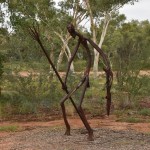A common question when visitors arrive in Alice Springs is “What should I see here?” Here are the top 10 things we recommend.
The first place we usually recommend starting is Alice Springs Desert Park. The Desert Park is a great place to see plants and animals of Central Australia. There are 3 desert habitats where you can see and learn about the flora and fauna in each. You can see emus, dingoes, and kangaroos, watch a free-flying bird show, have a close encounter with a wedge-tail eagle and visit the nocturnal house to see the mammals and reptiles that come out at night in the Outback.



Next is the Alice Springs Telegraph Station. When the Overland Telegraph Line was built, they chose to build a repeater station at Alice’s Spring which they thought was a permanent waterhole. Here you can get a glimpse of life for the early European settlers and the operation of the Telegraph Station, as well as it later use as an education centre for part aboriginal children known as the Bungalow; a wartime army base during World War 2; and an aboriginal reserve.


To continue learning about the history of Alice Springs, enjoy the Heritage Walk in the Central Business District. This is a self-guided tour of the town centre which highlights 9 historic buildings and attractions. Three of the stops are also a part of The Flynn Trail: Flynn Memorial Church, Adelaide House, and Royal Flying Doctor Service Tourist Facility.




When you think about Australia, kangaroos are usually the first thing that come to mind. Visit The Kangaroo Sanctuary and meet Kangaroo Dundee (BBC UK/Animal Planet) and his mob of kangaroos. You may even have the opportunity to hold one of the joeys.



Camels might not be the first animal that comes to mind when thinking of Australia, but they played an important role in the Outback. Afghan Cameleers drove their camel trains to deliver essential provisions, until they were replaced by the railway. Learn about their history in Australia and enjoy a camel ride along the backdrop of the West MacDonnell Ranges.


To learn about Australia’s road transport heritage, visit National Road Transport Hall of Fame. National Road Transport Hall of Fame, the Old Ghan Train Railway Museum, the Kenworth Dealer Truck Museum and the Miniature Railway collectively make up the most comprehensive land transport museum in the southern hemisphere.



Enjoy a guided tour of the Northern Territory’s oldest working cattle station, Undoolya Station, and enjoy views of the East MacDonnell Ranges.

Visit Olive Pink Botanic Gardens, Australia’s only arid zone botanic garden, where five self-guided walks take you around the garden. Keep your eyes open for interesting sculptures.




While at the Botanic Gardens, enjoy the walk up Meyers Hill where great vistas of Alice Springs can be viewed.


No visit to Alice Springs can be complete without experiencing the aboriginal art. Alice Springs has a number of art galleries and the Araluen Cultural Precinct where you can appreciate a range of paintings, weaving, sculpture and artefacts.


Finally, for number 10, we suggest you visit the world’s largest classroom, covering more than 1.3 million square kilometres (502,000 square miles) at Alice Springs School of the Air. The school makes it possible for children living in remote Central Australia to participate in school classes from preschool to year 9. A visit with a duration of 45-60 minutes is recommended. This includes enough time to view their film, a guide presentation and observe a live or recorded lesson, as well as an opportunity to enjoy their displays and shop.


We’d like to offer you a bonus – 2 more “must see” places – West MacDonnell Ranges and East MacDonnell Ranges. The Ranges stretch over 650 km running east-west through Alice Springs. The Larapinta Trail extends over 223 kilometres along the backbone of the West MacDonnell Ranges, going from Alice Springs Telegraph Station to Mount Sonder. The tallest mountains in the Northern Territory are found in the West MacDonnell Ranges, along with several permanent and semi-permanent waterholes nestled in the gaps and gorges. Enjoy swimming at Ellery Creek Big Hole, Ormiston Gorge, Redbank Gorge and Glen Helen Gorge. The waterholes are also a good place to do some bird-watching. Camping is available at Ellery Creek Big Hole, Redbank Gorge, Serpentine Chalet, and Ormiston Gorge; camping fees apply and are payable at each camping area. Walking is a good way to experience the various gaps and gorges. There are many marked trails ranging from easy to challenging. There is information about the natural and cultural environment at each site.


The East MacDonnell Ranges are not as well-known as the West MacDonnell Ranges, but they do provide beautiful scenery for walking, camping and four-wheel-driving. You can also visit Arltunga, a ghost town that was the site of gold mining in the 1930’s. Camping is available at Trephina Gorge, John Hayes Rock Hole, Ruby Gap, N’Dhala Gorge and Ross River Resort; some offer bush camping, others offer pit toilets, picnic tables and drinking water. Camping fees apply and are payable at each camping area.





